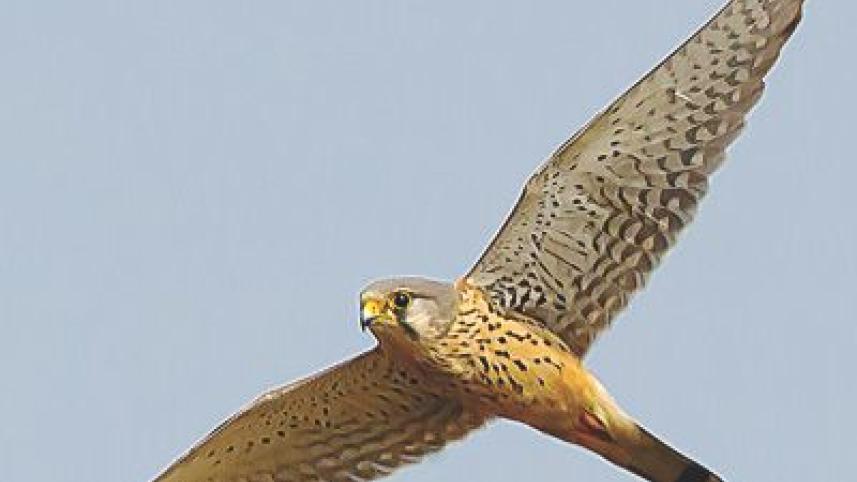Common Kestrel

I started using the 300-foot road in Purbachol early to take shortcuts on my way to and from Sylhet. In its infancy it was a gravel road full of bumps and potholes but it still beat the merciless traffic jams of Kaliganj Road. After monsoon one year, the entire length of the road took on the profile of a wave, my car going up and down the wave's ripples like a boat bouncing up and down with ocean waves. It was during one of these trips that I saw a medium-sized reddish bird sitting on the median of the road. Having never seen it before, I stopped the car and came in closer for a photograph. It played with me for a bit and then flew away.
Later at home, I identified the photograph as a common kestrel.
Belonging to the family Falconiidae, the common kestrel is our commonest falcon. It is about 36 centimeters in length, a bit larger than a house crow. The female is slightly larger than the male and has a reddish crown, contrasting with the male's grey crown. In flight, its fanned-out tail looks splendid with a black band and white tips cutting across it. Its wingtips are pointed. Like many other falcon species, a vertical black mark drops from its eyes down its face.
Since that day I have been able to observe kestrels numerous times in Purbachol during winter. They can be found perched at high places - on top of the pylons, or tall palms - scattered around the Purbachol fields. Usually they are patiently scanning for food, particularly insects such as grasshoppers, locusts, beetles, crickets, termites, rodents, voles, frogs and lizards. Their eyesight is superior and sensitive to ultra-violet rays. This enables them to track urine trails of rodents.
Observing the kestrels with patience can yield clues to their behaviour. For example, when hunting, they often hover over one spot 10-20 meters from the ground while pinpointing their prey which they swoop down to catch with their sharp talons. I have also seen them stomping repeatedly on a prey to kill it before flying off with it.
Most birds of prey are shy, but common kestrels, when hunting, can come near humans. This also goes for when they guarding their territory. Normally they fly away quickly as I approach them, but when they are hunting, I had kestrels swing around in flight and return for a closer look at me. Perhaps they wanted to chase me away from their territory or perhaps they were sizing up a prospective lunch, who knows?
Common kestrels are uncommon, seasonal birds in Bangladesh, spending the winter months here and leaving for cooler climates as our weather warms in spring. They can be found all over Europe, Asia and Africa and the countries of South Asia. Next time you are in Purbachol or other open rural areas, keep an eye on tall perches – pylons, brick chimneys, tall denuded trees - and you might spot one.
www.ihtishamkabir.com



 For all latest news, follow The Daily Star's Google News channel.
For all latest news, follow The Daily Star's Google News channel.
Comments